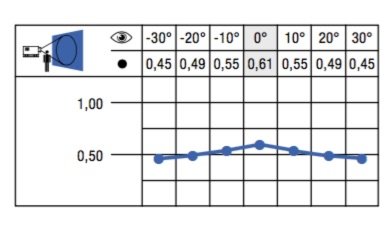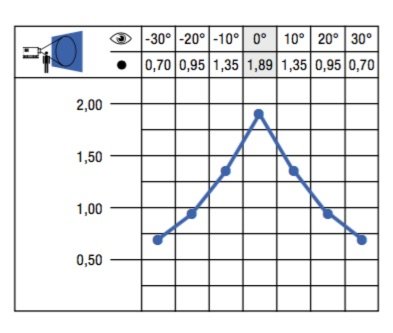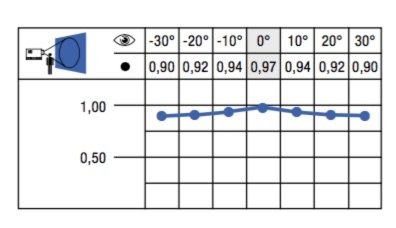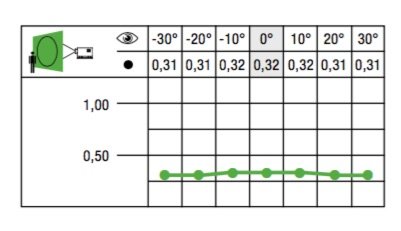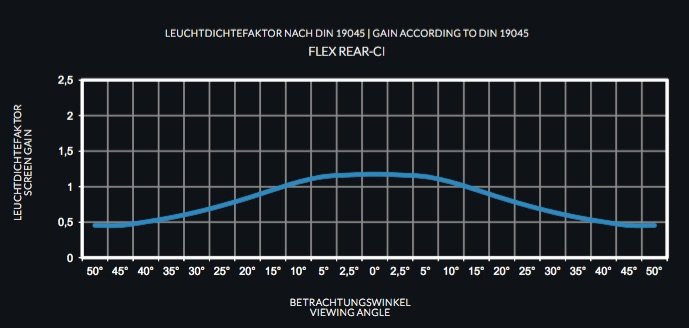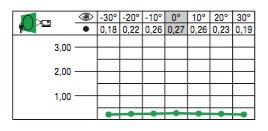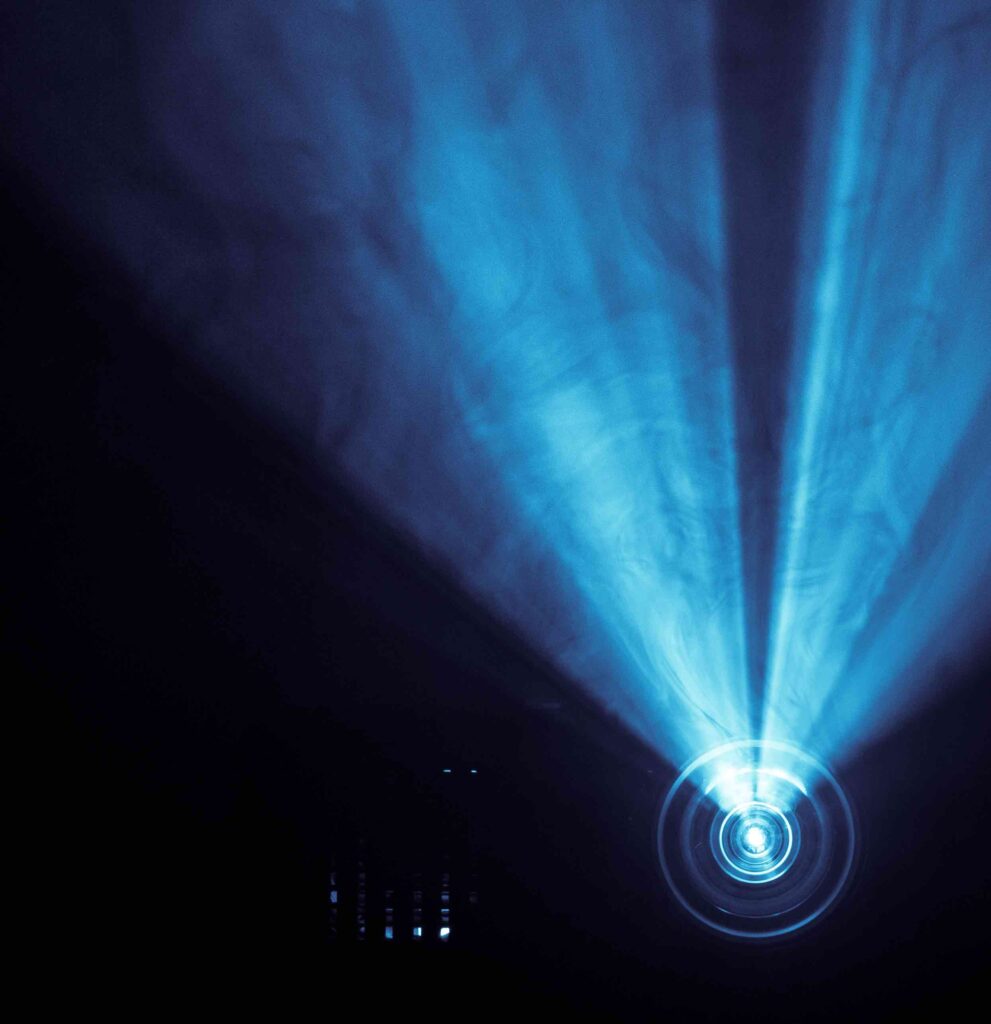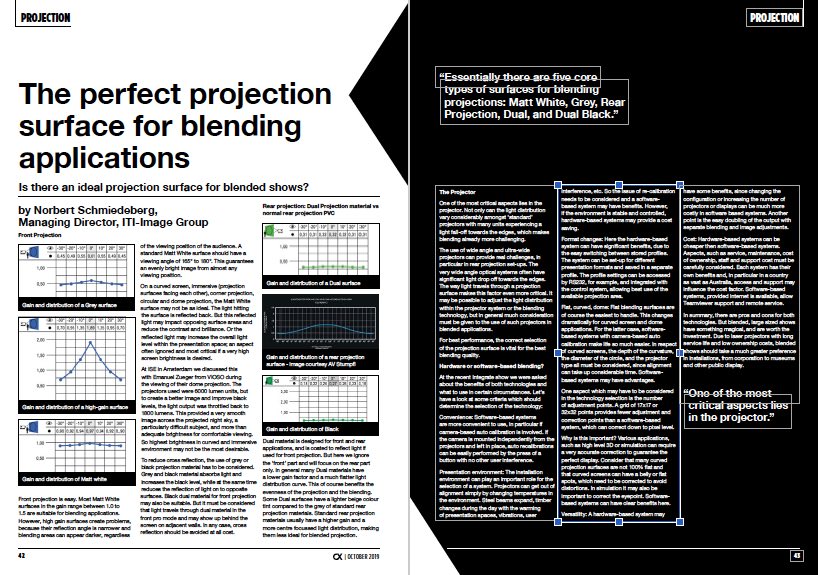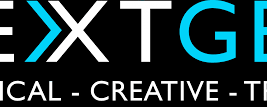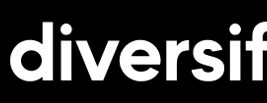News
23 Oct 2019
The Perfect Projection Surface for Blending
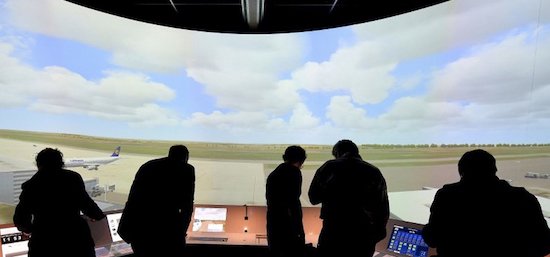
Subscribe to CX E-News
PROJECTION
The Perfect Projection Surface for Blending Applications
Is there an ideal projection surface for blended shows?
by Norbert Schmiedeberg, Managing Director, ITI-Image Group
Front Projection
Images L-R: Gain and distribution of a Grey surface; Gain and distribution of a high-gain surface; Gain and distribution of Matt white
Front projection is easy. Most Matt White surfaces in the gain range between 1.0 to 1.5 are suitable for blending applications. However, high gain surfaces create problems, because their reflection angle is narrower and blending areas can appear darker, regardless of the viewing position of the audience.
A standard Matt White surface should have a viewing angle of 165° to 180°. This guarantees an evenly bright image from almost any viewing position.
On a curved screen, immersive (projection surfaces facing each other), corner projection, circular and dome projection, the Matt White surface may not be as ideal. The light hitting the surface is reflected back. But this reflected light may impact opposing surface areas and reduce the contrast and brilliance. Or the reflected light may increase the overall light level within the presentation space; an aspect often ignored and most critical if a very high screen brightness is desired.
At ISE in Amsterdam we discussed this with Emanuel Zueger from VIOSO during the viewing of their dome projection.
The projectors used were 6000 lumen units, but to create a better image and improve black levels, the light output was throttled back to 1800 lumens. This provided a very smooth image across the projected night sky, a particularly difficult subject, and more than adequate brightness for comfortable viewing.
So highest brightness in curved and immersive environment may not be the most desirable.
To reduce cross reflection, the use of grey or black projection material has to be considered. Grey and black material absorbs light and increases the black level, while at the same time reduces the reflection of light on to opposite surfaces.
Black dual material for front projection may also be suitable. But it must be considered that light travels through dual material in the front pro mode and may show up behind the screen on adjacent walls. In any case, cross reflection should be avoided at all cost.
Rear projection: Dual Projection material vs normal rear projection PVC
L-R: Gain and distribution of a Dual surface; Gain and distribution of a rear projection surface (image courtesy AV Stumpfl); Gain and distribution of Black
Dual material is designed for front and rear applications, and is coated to reflect light if used for front projection. But here we ignore the ‘front’ part and will focus on the rear part only.
In general many Dual materials have a lower gain factor and a much flatter light distribution curve. This of course benefits the evenness of the projection and the blending.
Some Dual surfaces have a lighter beige colour tint compared to the grey of standard rear projection materials. Standard rear projection materials usually have a higher gain and a more centre focussed light distribution, making them less ideal for blended projection.
The Projector
One of the most critical aspects lies in the projector. Not only can the light distribution vary considerably amongst ‘standard’ projectors with many units experiencing a light fall-off towards the edges, which makes blending already more challenging.
The use of wide angle and ultra-wide projectors can provide real challenges, in particular in rear projection set-ups. The very wide angle optical systems often have significant light drop off towards the edges.
The way light travels through a projection surface makes this factor even more critical. It may be possible to adjust the light distribution within the projector system or the blending technology, but in general much consideration must be given to the use of such projectors in blended applications.
For best performance, the correct selection of the projection surface is vital for the best blending quality.
Hardware or software-based blending?
At the recent Integrate show we were asked about the benefits of both technologies and what to use in certain circumstances. Let’s have a look at some criteria which should determine the selection of the technology:
Convenience: Software-based systems are more convenient to use, in particular if camera-based auto calibration is involved. If the camera is mounted independently from the projectors and left in place, auto recalibrations can be easily performed by the press of a button with no other user interference.
Presentation environment: The installation environment can play an important role for the selection of a system. Projectors can get out of alignment simply by changing temperatures in the environment. Steel beams expand, timber changes during the day with the warming of presentation spaces, vibrations, user interference, etc. So the issue of re-calibration needs to be considered and a software- based system may have benefits. However, if the environment is stable and controlled, hardware-based systems may provide a cost saving.
Format changes: Here the hardware-based system can have significant benefits, due to the easy switching between stored profiles. The system can be set-up for different presentation formats and saved in a separate profile. The profile settings can be accessed by RS232, for example, and integrated with the control system, allowing best use of the available projection area.
Flat, curved, dome: Flat blending surfaces are of course the easiest to handle. This changes dramatically for curved screen and dome applications. For the latter case, software-based systems with camera-based auto calibration make life so much easier. In respect of curved screens, the depth of the curvature, the diameter of the circle, and the projector type all must be considered, since alignment can take up considerable time.
Software-based systems may have advantages.One aspect which may have to be considered in the technology selection is the number of adjustment points. A grid of 17×17 or 32×32 points provides fewer adjustment and correction points than a software-based system, which can correct down to pixel level.
Why is this important? Various applications, such as high level 3D or simulation can require a very accurate correction to guarantee the perfect display. Consider that many curved projection surfaces are not 100% flat and that curved screens can have a belly or flat spots, which need to be corrected to avoid distortions. In simulation it may also be important to correct the eyepoint. Software-based systems can have clear benefits here.
Versatility: A hardware-based system may have some benefits, since changing the configuration or increasing the number of projectors or displays can be much more costly in software based systems. Another point is the easy doubling of the output with separate blending and image adjustments.
Cost: Hardware-based systems can be cheaper then software-based systems. Aspects, such as service, maintenance, cost of ownership, staff and support cost must be carefully considered. Each system has their own benefits and, in particular in a country as vast as Australia, access and support may influence the cost factor. Software-based systems, provided internet is available, allow Teamviewer support and remote service.
In summary, there are pros and cons for both technologies. But blended, large sized shows have something magical, and are worth the investment. Due to laser projectors with long service life and low ownership costs, blended shows should take a much greater preference in installations, from corporation to museums and other public display.
CX Magazine – Oct 2019 Entertainment technology news and issues for Australia and New Zealand – in print and free online www.cxnetwork.com.au
© CX Media
Lead image: ViosoApp – ITI-Image Group
Subscribe
Published monthly since 1991, our famous AV industry magazine is free for download or pay for print. Subscribers also receive CX News, our free weekly email with the latest industry news and jobs.

